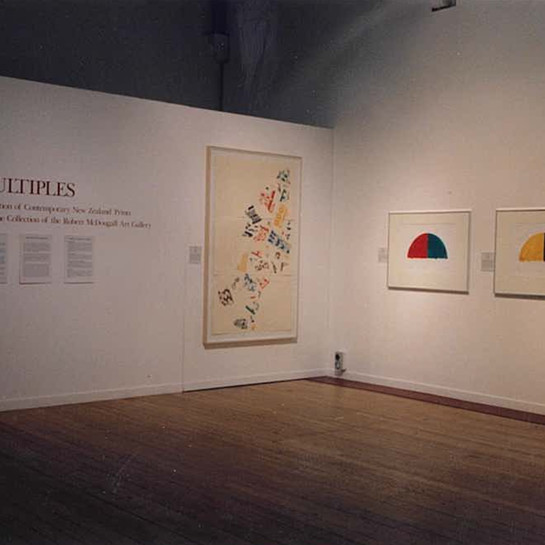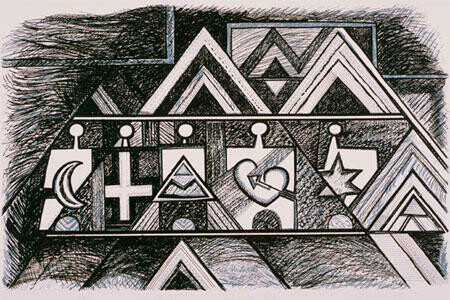Para Matchitt
Aotearoa New Zealand, b.1933, d.2021
Ngāti Porou,
Te Whānau ā Apanui,
Te Whakatōhea,
Māori
Huakina
- 1986
- Serigraph
- Presented by NZI Corporation, 1986
- 700 x 1000mm
- 86/59
Tags: crescents (motifs), crosses (motifs), hearts (motifs), Māori (culture or style), meeting houses (religious buildings), moons, mountains, stars (motifs), symbols, triangles (polygons)
The crescent, cross, triangle, heart and star forms are Mâori weaving designs that Para Matchitt has re-interpreted in a new context. They are intended for symbolic as well as decorative effect. Dominating this composition is the triangle, which symbolises both a mountain and meeting house. Huakina is a typical example of Matchitt's work, which often combines decorative imagery with modern materials and techniques. Here he has used the technique of serigraphy, which is also known as silkscreen printing. Matchitt was born at Tokomaru Bay, on the East Coast of the North Island. He was educated at Auckland and Dunedin Teachers' Colleges. In 1958 he was appointed the Mâori Arts and Crafts organiser for the South Auckland Education Board and has filled roles as an arts adviser in Wanganui, Hawke's Bay and Gisborne. Matchitt has exhibited both nationally and internationally since 1961, including at the Paris Biennale in 1964.
Exhibition History
Paratene Matchitt is one of New Zealand's senior Maori artists and belongs to the Ngati Porou. Influenced by the master carver Pine Taiapa, Para Matchitt was selected in the 1950s by the educationalist Gordon Tovey to train as a special Maori art teacher. He was to encourage young Maori to develop artistic skills and keep alive their ancient traditions. Today, Para Matchitt is greatly respected for the work he has done in this field.
Paratene Matchitt is also a major sculptor and artist specialising in mulit-media works which frequently combine traditional Maori motifs with European methods and materials. His style, with its abstract geometric forms, is well displayed in this print. Huakina, a screenprint is associated with a large wooden sculptural installation, which was constructed at the National Art Gallery, Wellington, in 1986.
The symbolism used in this work is related to Te Kooti, his life and the images used in the Ringatu religion. The star, heart, cross and moon symbols were used on Te Kooti's flag. Central to these, and dominating this composition, is the triangle. This is often used by the Maori artist to symbolise the tribal mountain and the meeting house with which the Maori artist associates his identity.
In Huakina Para Matchitt combines his past and his present and celebrates contemporary creativity and achievement in Maori culture.
(Label date unknown)


